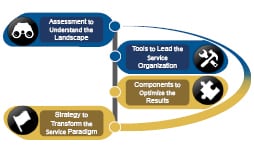How Service Leaders Succeed in the New Economy

If you examine the profile of successful Service Leaders, you will find that there is no single qualification or degree to attribute to their success. In most cases, today’s leaders got there through the ‘school of hard knocks,’ some degree of luck and many years of experience in the service industry. While these leaders have been proficient, looking forward, what got them where they are today, won’t necessarily be sufficient for the service leaders of the future.
The New Economy
Since the financial downturn of 2008, businesses had to adapt to survive and thrive as the new global economy evolved. One of the major impacts to product-centric businesses is commoditization. Put simply, products are becoming similar causing competitive pressures, ultimately lowering prices which shrink margins and company profitability. As a survival strategy, many B to B product based companies had to make dramatic changes. They developed a new strategic paradigm which included investing in their service business and offering more client-centric solutions which bundle services with their product to solve industry or client specific business issues. The ultimate objective was to drive real customer success. The service quotient of the total solution helps cement a more lasting client relationship as a strategic partner rather than just a vendor. Overall revenues and margins from this type of business model far exceed the traditional product dominant approach.
In this new economy, the Service’s function has a much higher profile and plays a more critical role in the longevity of the corporation. Consequently, the Service Leader of the future must have higher level skills to set strategy and guide the organization as they transition to this new business model.

The Skills of Future Service Leaders
Know How to Run Service as a Business
This requires knowledge of industry economics and fundamental financial management. At a minimum, they must be able to read and analyze financial statements, understand how to perform cost/benefits analysis, develop the financial justification for new capital acquisitions which deliver a positive ROI, and include Net Present Value in the calculation. The new service leader is required to manage their business as a stand-alone P&L and make a significant contribution to company revenue and overall profitability.
Technology Trends and Innovations
Understand all the latest Information Technology (IT) trends and determine if any technology could be applied and leverage in the service operation to drive efficiencies and add value to customers. There are many innovative technologies available to enhance services such as IoT, Augmented Reality, Artificial Intelligence, BOT’s, Data Analytics, Knowledge management, etc. The service leader needs to constantly monitor these IT trends, evaluate the merits of each technology, and determine how to integrate the technology into their service model.
Capacity and Resource Management
Leverage capacity and resource management tools to evaluate viable opportunities to increase productivity and maximize efficiency. This includes how to scale the business quickly to meet either increased or declining service demand. Outsourcing nearshore or offshore should be options that Service Leaders need to evaluate thoroughly as well. Another resource factor to consider is the generational changes in the workforce with the influx of millennials and retiring baby boomers. Older management techniques to hire and motivate staff may not be as effective in the future.
Change Management
Every organization is undergoing some form of change. Unfortunately, most of these change initiatives fail due to internal resistance because the organization lacks a change management methodology. Service organizations need to transform in order to play a more significant role within the corporate structure. This transformation requires new leadership skills to sponsor change and to engage change agents to drive success for every organizational change, whether it be large or small.
Service Delivery Model Awareness
Service Delivery Models vary widely and can depend on the type of service being delivered. The primary technology services are Field Service, Technical Support, Web Self Service and Professional Services. Many of the traditional delivery models are outdated and haven’t adapted to the changing needs of the customer. Too often companies are delivering service based on what is convenient for them rather than what the customer wants. Clients want more advance outcome based services. Leaders need to do a better job of evaluating the driving factors that influence their service delivery model and prepare to adopt more responsive and dynamic service delivery processes. Innovative variations to account management and collaborative service are examples of new service delivery options that leaders need to prepare to embrace.
Service Marketing and Branding
While services provide intangible value that is very significant, it seldom gets the same marketing attentions as the company’s product. As mentioned earlier, many companies are starting to leverage service as a key differentiator to mitigate product commodification. The new service leader needs to understand the value of marketing, how to create new viable service propositions complete with pricing strategies that align the service and corporate brand image.
Customer Experience Alignment
Developing a complete and accurate view of the overall customer experience has become a major focus in recent years. It is a complicated process because all customers don’t share the same needs, so some level of segmentation is required. The service organization has the most direct contact with customers, more so than any other organizations within your company. A method called “Journey Mapping” can be used to identify all the touch points your company has with the customer. The data derived from this can be used to streamline every interaction to improve the overall customer experience. The service leader is ultimately responsible for ongoing customer adoption and loyalty, therefore should be the key executive and driver of any corporate customer experience program.
Service Strategy Development
Many service organization operate in a constant reactive mode and seldom get the necessary resources to deliver a consistent quality service experience to customers. For this to change, it is imperative that the Service Leaders commit to creating a vision for services and a strategic plan to implement this vision successfully. They need to understand the various business strategy frameworks and use whichever is most appropriate for their situation. The strategy should have a horizon of at least three years and with segments for immediate, mid term and long term planning phases. Equally important is to link the service strategy with the corporate strategy and to ensure all senior level executives are aligned and engaged to support the execution of the strategy.
Service Leadership
The fundamentals of leadership haven’t changed. It starts with focusing on your people. Having the ability to create a vision that will inspire and motivate staff to achieve the desired objectives. What has changed is the economic landscape and the additional skills outlined for future service leaders highlights how demanding this role has become. Ongoing training is essential to develop and enhance these skills so that Leaders can anticipate future service demands, create the strategies to drive the business forward, implement the required changes effectively, market the service brand to achieve a balance of customer success and loyalty as well as profitable growth to the company.
A New Program to Develop Service Leaders
A new educational program for Service Leaders has been developed and will launch in June 2017. Service Strategies developed this unique four-day course based on input from many service executives. Learn more about the Service Leadership course.
The course covers all the skills and topics mentioned above and also covers:
- Communication skills for setting an appropriate tone to unlock employee engagement, buy-in, and commitment
- Tools to help you analyze your service business, develop a plan, and make more impactful service strategy decisions
- Essential leadership skills to help you develop the people around you so you can execute on a service transformation
Executives that attend this course will also learn the most advanced leadership skills using tools to fully develop and execute a comprehensive strategy for their service organizations. Upon completion of the course, participants will have the skills necessary to successfully lead a service organization with confidence and purpose. Based on successful completion of the program, which includes a post class project, participants will also achieve a Certified Service Leader accreditation.
Leave a Comment